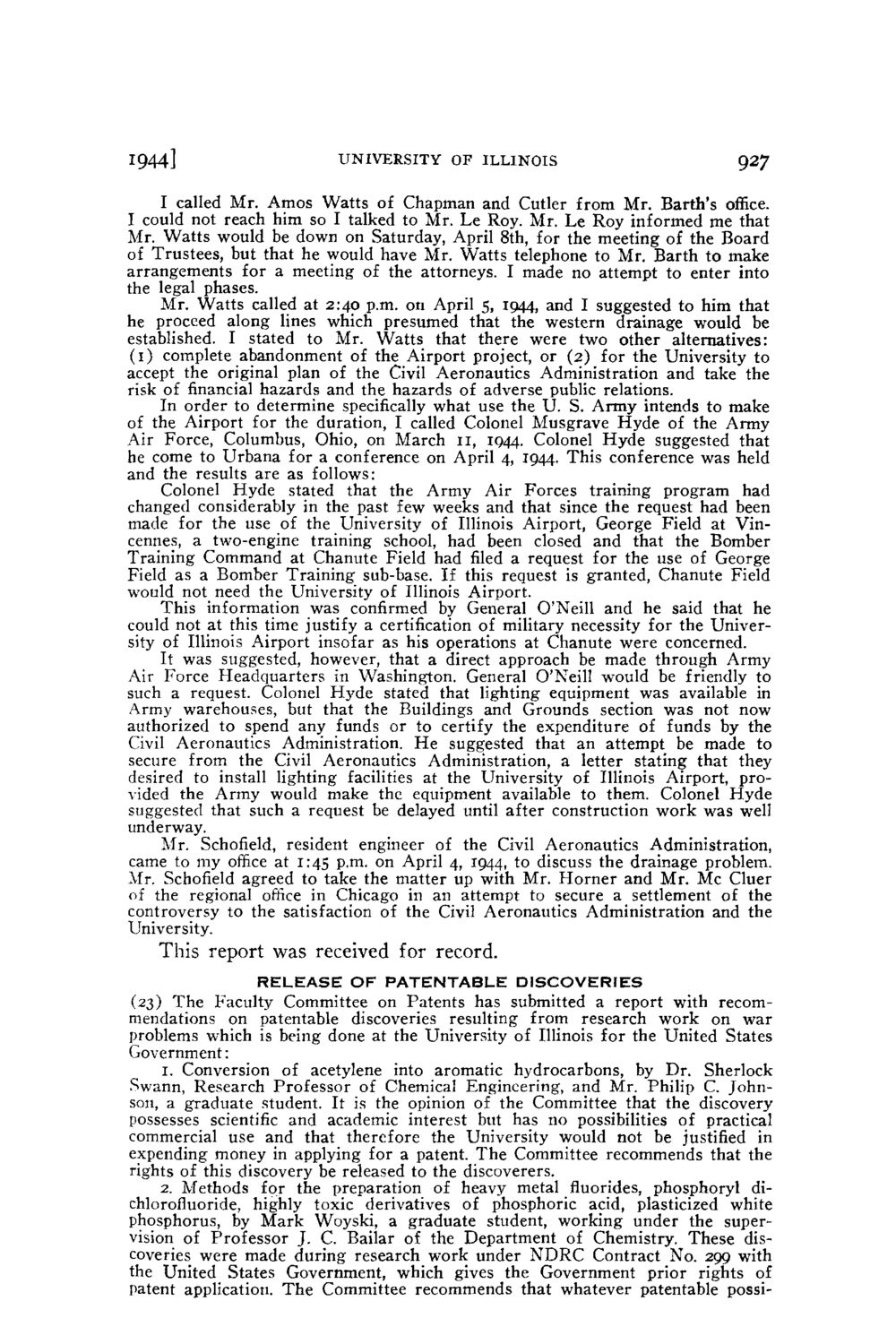| |
| |
Caption: Board of Trustees Minutes - 1944
This is a reduced-resolution page image for fast online browsing.

EXTRACTED TEXT FROM PAGE:
1944] UNIVERSITY OF ILLINOIS 927 I called Mr. Amos Watts of Chapman and Cutler from Mr. Barth's office. I could not reach him so I talked to Mr. Le Roy. Mr. Le Roy informed me that Mr. Watts would be down on Saturday, April 8th, for the meeting of the Board of Trustees, but that he would have Mr. Watts telephone to Mr. Barth to make arrangements for a meeting of the attorneys. I made no attempt to enter into the legal phases. Mr. Watts called at 2:40 p.m. on April 5, 1944, and I suggested to him that he proceed along lines which presumed that the western drainage would be established. I stated to Mr. Watts that there were two other alternatives: (1) complete abandonment of the Airport project, or (2) for the University to accept the original plan of the Civil Aeronautics Administration and take the risk of financial hazards and the hazards of adverse public relations. In order to determine specifically what use the U. S. Army intends to make of the Airport for the duration, I called Colonel Musgrave Hyde of the Army Air Force, Columbus, Ohio, on March 11, 1044. Colonel Hyde suggested that he come to Urbana for a conference on April 4, 1944. This conference was held and the results are as follows: Colonel Hyde stated that the Army Air Forces training program had changed considerably in the past few weeks and that since the request had been made for the use of the University of Illinois Airport, George Field at Vincennes, a two-engine training school, had been closed and that the Bomber Training Command at Chanute Field had filed a request for the use of George Field as a Bomber Training sub-base. If this request is granted, Chanute Field would not need the University of Illinois Airport. This information was confirmed by General O'Neill and he said that he could not at this time justify a certification of military necessity for the University of Illinois Airport insofar as his operations at Chanute were concerned. It was suggested, however, that a direct approach be made through Army Air Force Headquarters in Washington. General O'Neill would be friendly to such a request. Colonel Hj'de stated that lighting equipment was available in Army warehouses, but that the Buildings and Grounds section was not now authorized to spend any funds or to certify the expenditure of funds by the Civil Aeronautics Administration. H e suggested that an attempt be made to secure from the Civil Aeronautics Administration, a letter stating that they desired to install lighting facilities at the University of Illinois Airport, provided the Army would make the equipment available to them. Colonel Hyde suggested that such a request be delayed until after construction work was well underway. Mr. Schofield, resident engineer of the Civil Aeronautics Administration, came to my office at 1:45 p.m. on April 4, 1944, to discuss the drainage problem. Mr. Schofield agreed to take the matter up with Mr. H o r n e r and Mr. Mc Cluer of the regional office in Chicago in an attempt to secure a settlement of the controversy to the satisfaction of the Civil Aeronautics Administration and the University. This report was received for record. R E L E A S E O F PATENTABLE DISCOVERfES (23) T h e Faculty Committee on Patents has submitted a report with recommendations on patentable discoveries resulting from research work on war problems which is being done at the University of Illinois for the United States Government: 1. Conversion of acetylene into aromatic hydrocarbons, by Dr. Sherlock Swann, Research Professor of Chemical Engineering, and Mr. Philip C. Johnson, a graduate student. It is the opinion of the Committee that the discovery possesses scientific and academic interest but has no possibilities of practical commercial use and that therefore the University would not be justified in expending money in applying for a patent. T h e Committee recommends that the rights of this discovery be released to the discoverers. 2. Methods for the preparation of heavy metal fluorides, phosphoryl dichlorofluoride, highly toxic derivatives of phosphoric acid, plasticized white phosphorus, by M a r k Woyski, a graduate student, working under the supervision of Professor J. C. Bailar of the Department of Chemistry. These discoveries were made during research work under N D R C Contract No. 299 with the United States Government, which gives the Government prior rights of patent application. T h e Committee recommends that whatever patentable possi-
| |